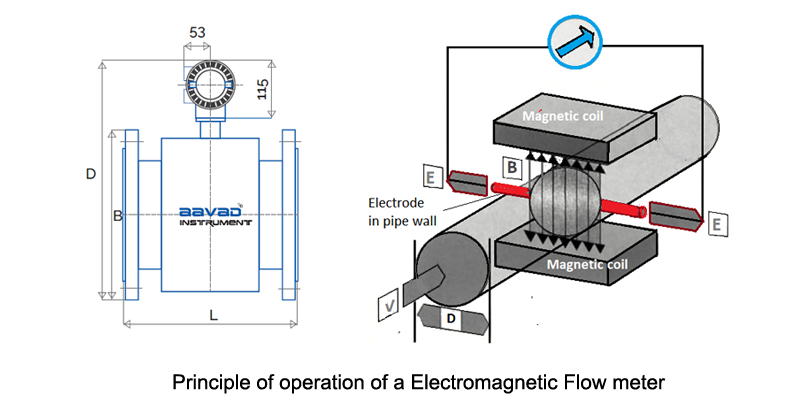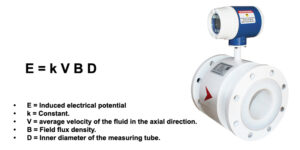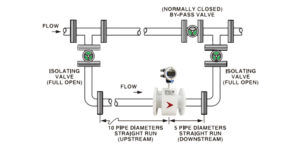
As per Michael Faraday, electric current can be generated by a magnetic field.
According to Faraday’s law of electromagnetic induction, whenever a conductor is placed in a magnetic field, an emf is induced which is called induced emf.
Two field coils are located inside of the magnetic flowmeter with the help of pole shoes. These coils generate a magnetic field on the entire cross-section of the measuring tube.
Two electrodes that can pick up electrical voltages are installed at right angles. The lining which is fitted inside the wall prevents an electrical short circuit between conductive fluid and the metal body.
If there is no liquid flow, no induced voltages are measured between the electrodes, and electrically charged particles are evenly distributed. As soon as the flow starts inside the tube, the magnetic field applies a force to the charged particles. the positively charged particles are separated get collected on the opposite sides of the flow tube. The electric voltage is formed which is detected by the two electrodes.
The electric voltages depend on the flow velocity inside the tube. Together with the tube cross-section, flow volume can be calculated. Greater the flow velocity, the greater the separation of charged particles.

Materials of Construction:
Liners: Ceramic, neoprene, Polyurethane, Rubber, Teflon, Vitreous Ceramic kynar.
Electrodes: Platinum, Hastelloy C, Stainless Steel, Tantalum, Tungsten carbide, Monel, and Nickel.
Horizontal installation

Vertical installation

Advantages
- No moving parts which are prone to wear & unreliability.
- Obstruction less measurement with nothing projecting into the flow stream.
- Good accuracy (0.5 %).
- Virtually no pressure drop. Pumping costs are therefore minimized.
- Can be used in pipelines of any size.
- Can handle flows with a high level of solids that not be measured with any type of flow meter.
- Support a variety of liners. Sanitary liners for hygienic applications, inert liners for corrosive.
- The incentive to viscosity, specific gravity, temperature, pressure.
- Mag flow meters work with Laminar, Turbulent, and Transitional flows.
Limitations
- Magnetic flow meters are restricted to liquids where conductivity is at sufficient levels to induce a measurable voltage.
- Unable to measure the flow of Hydrocarbons due to their low conductivity.
- Typically require a pipe full of flowing fluid.
- Magnetic flowmeters can not be used to measure gas flows.
- The pipe must normally be grounded. Failure to properly ground the pipe can result in flow signal fluctuation.












